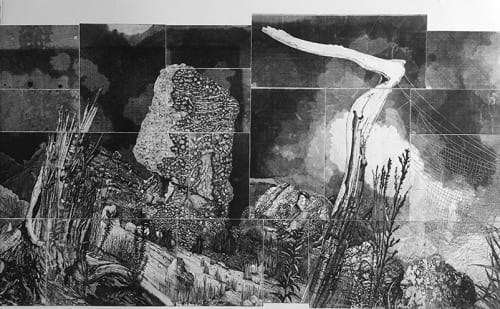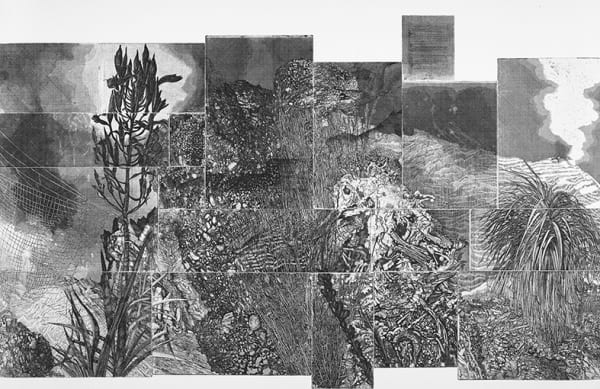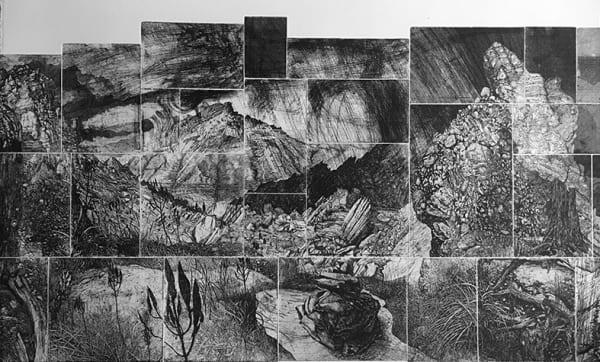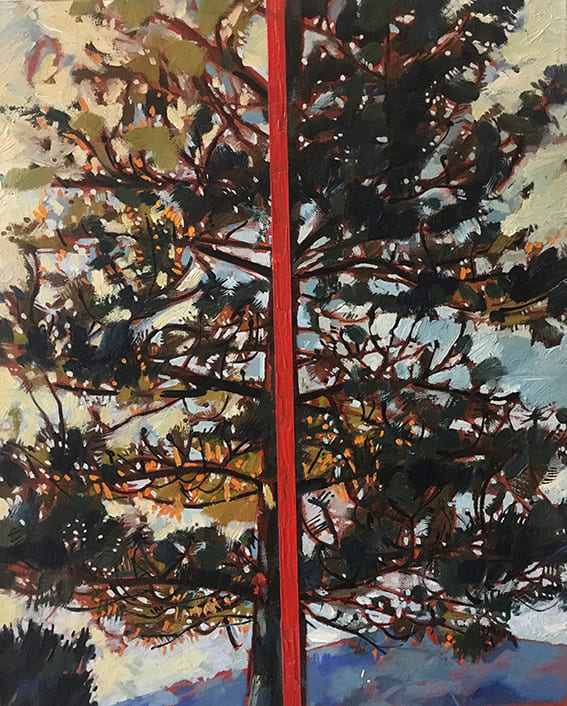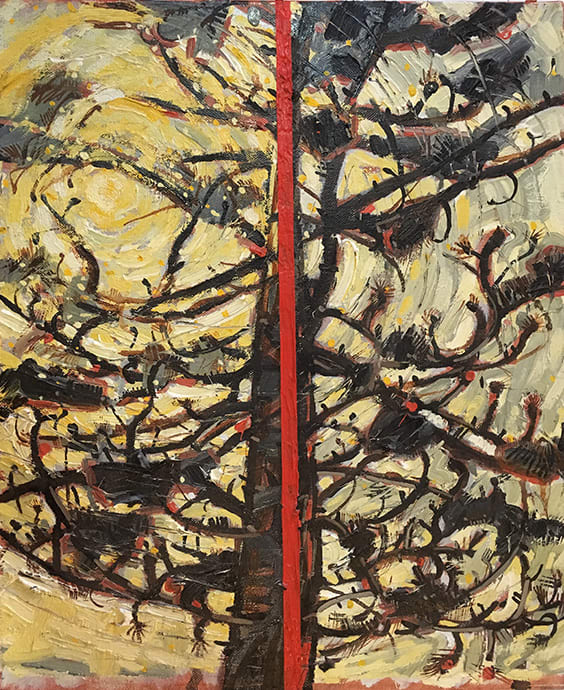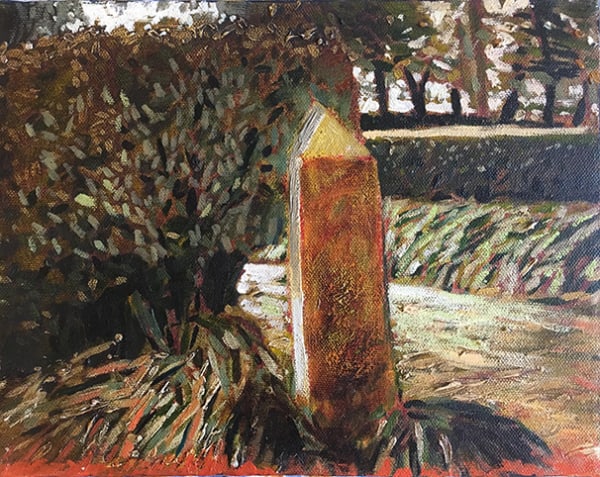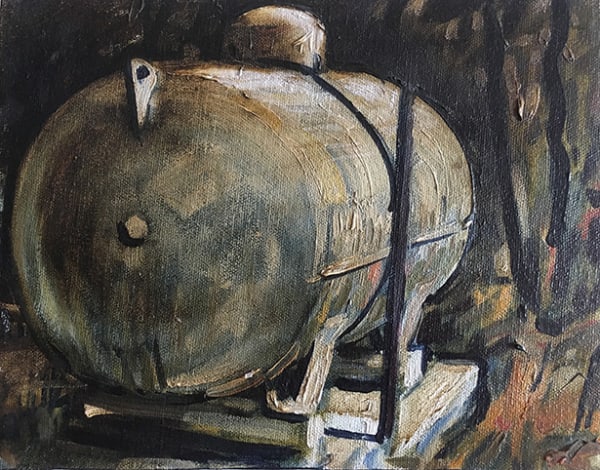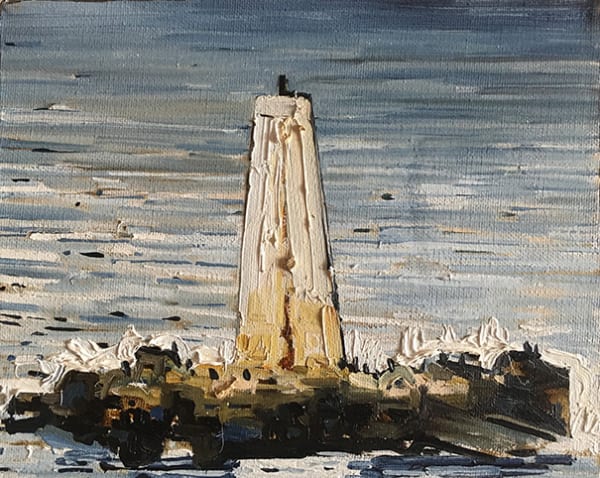Raymond Arnold: Prospect and Refuge
In the early 1980s I had developed several large prints about the landscape of this same western Tasmania. They were ’postcards’ for imaginary audiences far over the horizon – images of wild, desolate, indifferent places just beginning to feel the pressure of the approaching bulldozer.
Imaginary Landscape – Eighteen months in Tasmania (1984) and Florentine Valley: displaced landscape (1984) were big panoramic images intended for audiences in big city galleries. That is where they rest now – in National and State Gallery collections, in plan drawers and in dark quiet archives beyond the gaze.
My new print work ‘bookends’ that earlier work. It shares some characteristics with those artworks from 30 years ago but essentially it represents a big change. That shift in meaning and context is bound up with the fact that I live and will hopefully die within the pictured landscape and that the audience for these paintings surrounds me in the ‘here and now’. I began developing new etchings of some terrain on Mt Lyell, near Queenstown, which is still heavily scarred from late 19th century/early 20th century mining impacts. Plants are re-colonising the area, however, with the White Waratah, Blandfordia punicea or Christmas bells, Celery top pine and even King Billy pine in evidence. It is in this sense of the possibility of another world, ie. one that is lost but one that might be reclaimed that I was interested in speculating on in the new work. John Lendis, an English painter and friend, co-incidently sent me a volume of Seamus Heaney poems during this early phase of the etchings development. I found the words for a title of the new etchings in that book:
…an elsewhere world.
Where can it be found again,
An elsewhere world, beyond Maps and atlases,
Where all is woven into
And of itself, like a nest
Of crosshatched grass blades?
I see the project as a way of rounding off my print oeuvre and the culmination of a lifetime’s work. I see it as a way ofbringing a type of stability or balance to the array of projects and print outcomes I’ve worked on since 1977 when I made those first connections to the print medium. I see it as a palimpsest of flora, fauna and geology I encounter on daily walks with my partner Helena and our pups in the Queenstown hills. I see it as an expression of how I now live and an expression of what I love!
Raymond Arnold
-
 Raymond ArnoldEtching Ghost/ Ghost Mountain I, 2015transitional image on 300gsm Velin Arches107 x 190 cmEdition of 10 plus 2 artist's proofsAU$ 1,050.00
Raymond ArnoldEtching Ghost/ Ghost Mountain I, 2015transitional image on 300gsm Velin Arches107 x 190 cmEdition of 10 plus 2 artist's proofsAU$ 1,050.00 -
 Raymond ArnoldEtching Ghost/ Ghost Mountain Acacia, 2016transitional image on 300gsm Velin Arches107 x 190 cmEdition of 10 plus 2 artist's proofsAU$ 1,050.00
Raymond ArnoldEtching Ghost/ Ghost Mountain Acacia, 2016transitional image on 300gsm Velin Arches107 x 190 cmEdition of 10 plus 2 artist's proofsAU$ 1,050.00 -
 Raymond ArnoldElsewhere world consolidated I, 2017etching on 300gsm Velin Arches, unframed80 x 115 cmSold
Raymond ArnoldElsewhere world consolidated I, 2017etching on 300gsm Velin Arches, unframed80 x 115 cmSold -
 Raymond ArnoldElsewhere world consolidated II, 2017etching on 300gsm Velin Arches, unframed80 x 115 cmAU$ 2,200.00
Raymond ArnoldElsewhere world consolidated II, 2017etching on 300gsm Velin Arches, unframed80 x 115 cmAU$ 2,200.00 -
 Raymond ArnoldElsewhere world consolidated III, 2017etching on 300gsm Velin Arches, unframed80 x 115 cmSold
Raymond ArnoldElsewhere world consolidated III, 2017etching on 300gsm Velin Arches, unframed80 x 115 cmSold -
 Raymond ArnoldElsewhere world consolidated IV (AP), 2017etching on 300gsm Velin Arches
Raymond ArnoldElsewhere world consolidated IV (AP), 2017etching on 300gsm Velin Arches
80 x 115 cmAU$ 2,200.00 -
 Raymond ArnoldLand Sprite, 2017transitional image on 300gsm Velin Arches, unframed60 x 126 cmAU$ 1,050.00
Raymond ArnoldLand Sprite, 2017transitional image on 300gsm Velin Arches, unframed60 x 126 cmAU$ 1,050.00 -
 Raymond ArnoldSummer; Ravin de Combaron - France, 1998oil on canvas, framed43 x 35 cmSold
Raymond ArnoldSummer; Ravin de Combaron - France, 1998oil on canvas, framed43 x 35 cmSold -
 Raymond ArnoldSummer; Montauban- France, 1998oil on canvas, framed43 x 35 cmSold
Raymond ArnoldSummer; Montauban- France, 1998oil on canvas, framed43 x 35 cmSold -
 Raymond ArnoldSummer; ’Ouvèze- France, 1998oil on canvas, framed43 x 35 cmSold
Raymond ArnoldSummer; ’Ouvèze- France, 1998oil on canvas, framed43 x 35 cmSold -
 Raymond ArnoldSummer; Montguers - France, 1998oil on canvas, framed43 x 35 cmSold
Raymond ArnoldSummer; Montguers - France, 1998oil on canvas, framed43 x 35 cmSold -
 Raymond ArnoldSummer; Buls-les-Baronnles - France, 1998oil on canvas, framed43 x 35 cmSold
Raymond ArnoldSummer; Buls-les-Baronnles - France, 1998oil on canvas, framed43 x 35 cmSold -
 Raymond ArnoldVoyage; La Spezia ‘Departure’, 1994oil on canvas, framed36 x 28 cmSold
Raymond ArnoldVoyage; La Spezia ‘Departure’, 1994oil on canvas, framed36 x 28 cmSold -
 Raymond ArnoldVoyage; Calabrian Coastline, 1994oil on canvas, framed36 x 49 cmSold
Raymond ArnoldVoyage; Calabrian Coastline, 1994oil on canvas, framed36 x 49 cmSold -
 Raymond ArnoldVoyage; Mediterranean Sea, 1994oil on canvas, framed23 x 38 cmAU$ 750.00
Raymond ArnoldVoyage; Mediterranean Sea, 1994oil on canvas, framed23 x 38 cmAU$ 750.00 -
 Raymond ArnoldVoyage; 24’E -35 ‘N, 1994oil on canvas,framed57 x 36cmAU$ 750.00
Raymond ArnoldVoyage; 24’E -35 ‘N, 1994oil on canvas,framed57 x 36cmAU$ 750.00 -
 Raymond ArnoldVoyage; Bitter Lake Suez, 1994oil on canvas, framed49 x 36cmSold
Raymond ArnoldVoyage; Bitter Lake Suez, 1994oil on canvas, framed49 x 36cmSold -
 Raymond ArnoldVoyage; Gulf of Suez 33E’ - 28N’, 1994oil on canvas,framed48 x 35 cm
Raymond ArnoldVoyage; Gulf of Suez 33E’ - 28N’, 1994oil on canvas,framed48 x 35 cm -
 Raymond ArnoldVoyage; Contship Germany, 1994oil on canvas, framed48 x 35 cmAU$ 750.00
Raymond ArnoldVoyage; Contship Germany, 1994oil on canvas, framed48 x 35 cmAU$ 750.00 -
 Raymond ArnoldVoyage; Red Sea May 31 1994, 1994oil on canvas, framed36 x 57 cmSold
Raymond ArnoldVoyage; Red Sea May 31 1994, 1994oil on canvas, framed36 x 57 cmSold -
 Raymond ArnoldVoyage; Gulf of Aden, 1994oil on canvas, framed38 x 31 cmSold
Raymond ArnoldVoyage; Gulf of Aden, 1994oil on canvas, framed38 x 31 cmSold -
 Raymond ArnoldVoyage; Indian Ocean, 1994oil on canvas, framed30 x 37 cmAU$ 750.00
Raymond ArnoldVoyage; Indian Ocean, 1994oil on canvas, framed30 x 37 cmAU$ 750.00 -
 Raymond ArnoldVoyage; Indian Ocean June 7th 1994, 1994oil on canvas, framed48 x 36 cmAU$ 750.00
Raymond ArnoldVoyage; Indian Ocean June 7th 1994, 1994oil on canvas, framed48 x 36 cmAU$ 750.00 -
 Raymond ArnoldVoyage; June 12th 1994, 1994oil on canvas, framed48 x 35 cmSold
Raymond ArnoldVoyage; June 12th 1994, 1994oil on canvas, framed48 x 35 cmSold -
 Raymond ArnoldVoyage; Great Australian Bight, 1994oil on canvas, framed47 x 36 cmAU$ 750.00
Raymond ArnoldVoyage; Great Australian Bight, 1994oil on canvas, framed47 x 36 cmAU$ 750.00 -
 Raymond ArnoldMemory; Clarendon - Nile Valley, 1990oil on canvas, framed23 x 28 cmSold
Raymond ArnoldMemory; Clarendon - Nile Valley, 1990oil on canvas, framed23 x 28 cmSold -
 Raymond ArnoldMemory; Stanley, 1988oil on canvas, framed23 x 28 cmSold
Raymond ArnoldMemory; Stanley, 1988oil on canvas, framed23 x 28 cmSold -
 Raymond ArnoldMemory; Mount Nelson, 1990oil on canvas, framed23 x 28 cmAU$ 550.00
Raymond ArnoldMemory; Mount Nelson, 1990oil on canvas, framed23 x 28 cmAU$ 550.00 -
 Raymond ArnoldMemory; Crotty Road, 1992oil on canvas, framed23 x 28 cmSold
Raymond ArnoldMemory; Crotty Road, 1992oil on canvas, framed23 x 28 cmSold -
 Raymond ArnoldMemory;Zeehan, 1990oil on canvas, framed23 x 28 cmSold
Raymond ArnoldMemory;Zeehan, 1990oil on canvas, framed23 x 28 cmSold -
 Raymond ArnoldMemory; South Arm, 1992oil on canvas, framed23 x 28 cmSold
Raymond ArnoldMemory; South Arm, 1992oil on canvas, framed23 x 28 cmSold -
 Raymond ArnoldMemory; West Lyell - Queenstown, 1991oil on canvas, framed23 x 28 cmAU$ 550.00
Raymond ArnoldMemory; West Lyell - Queenstown, 1991oil on canvas, framed23 x 28 cmAU$ 550.00 -
 Raymond ArnoldMemory; Wayatinah, 1992oil on canvas, framed23 x 28 cmSold
Raymond ArnoldMemory; Wayatinah, 1992oil on canvas, framed23 x 28 cmSold -
 Raymond ArnoldMemory; Philosopher Ridge - Mt Lyell, 1991oil on canvas, framed23 x 28 cmSold
Raymond ArnoldMemory; Philosopher Ridge - Mt Lyell, 1991oil on canvas, framed23 x 28 cmSold -
 Raymond ArnoldMemory; Maria Island I, 1992oil on canvas, framed23 x 28 cmSold
Raymond ArnoldMemory; Maria Island I, 1992oil on canvas, framed23 x 28 cmSold -
 Raymond ArnoldMemory; Mount Lyell Workshop, 1991oil on canvas, framed23 x 28 cmAU$ 550.00
Raymond ArnoldMemory; Mount Lyell Workshop, 1991oil on canvas, framed23 x 28 cmAU$ 550.00 -
 Raymond ArnoldMemory; Maria Island II, 1995oil on canvas, framed23 x 28 cmAU$ 550.00
Raymond ArnoldMemory; Maria Island II, 1995oil on canvas, framed23 x 28 cmAU$ 550.00 -
 Raymond ArnoldMemory; Blinking Billy, 1996oil on canvas, framed23 x 28 cmSold
Raymond ArnoldMemory; Blinking Billy, 1996oil on canvas, framed23 x 28 cmSold -
 Raymond ArnoldMemory; Strathmore - Nile Valley, 1991oil on canvas, framed23 x 28 cmAU$ 550.00
Raymond ArnoldMemory; Strathmore - Nile Valley, 1991oil on canvas, framed23 x 28 cmAU$ 550.00 -
 Raymond ArnoldI Gave Jamie, the Young Artist with Asbergers, a Book on Escher for Christmas, 2016Acrylic on linen, diptych102 x 153 cmAU$ 12,000.00
Raymond ArnoldI Gave Jamie, the Young Artist with Asbergers, a Book on Escher for Christmas, 2016Acrylic on linen, diptych102 x 153 cmAU$ 12,000.00 -
 Raymond ArnoldWestern Mine/ My Mother’s Tears, 2014Acrylic on linen, diptych, framed136 x 182 cmAU$ 12,000.00
Raymond ArnoldWestern Mine/ My Mother’s Tears, 2014Acrylic on linen, diptych, framed136 x 182 cmAU$ 12,000.00
